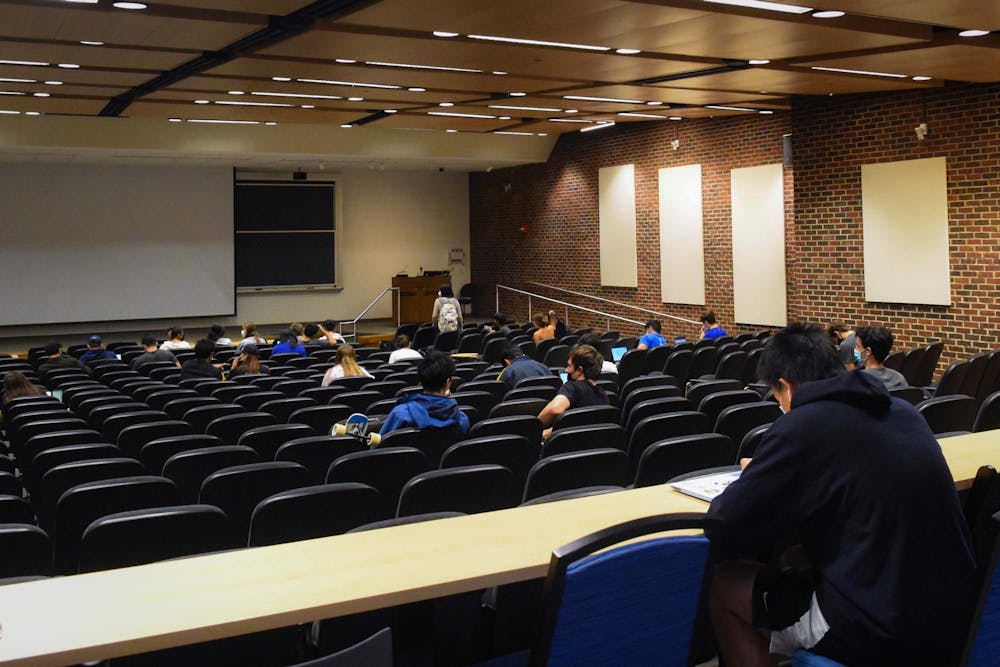One of the legacies of remote learning is the addition of video recording devices in many classrooms, a legacy that still plays an important role for students who can’t attend class due to COVID-19 related complications. This technological advancement also benefits the entire student body as more and more students choose to watch lecture recordings virtually in lieu of going to a physical classroom. While there have been voices pushing for a more flexible mode of teaching through online learning, Penn should take a step further and make all large lectures asynchronous through recordings.
The immediate effect of making large lectures asynchronous is that it will allow busy Penn students to manage their time more efficiently throughout the week. Instead of having to attend lectures at a given time on a specific day, students can watch the recording on their own time, offering them the flexibility to prioritize other commitments like projects or upcoming exams depending on their varying weekly schedule.
Further, online learning caters to the needs of different students. While some students with previous knowledge can watch a recording at a faster playback speed, others who find the course challenging are able to pause the recording to think about a difficult concept or go back to rewatch parts of the lecture that they don’t understand.
Contrary to some opinions, asynchronous lectures don’t reduce the level of engagement for students. The difference between large lectures and seminars is that the former doesn’t involve much direct interaction between the instructor and the students. Even if a student needed to ask a question or talk to the professor, they could always attend live office hours or use forums, such as Piazza, which allow instructors to answer questions remotely.
Instructor-student engagement for lecture-based classes typically occurs during recitations or group projects. Some might worry that asynchronous lectures prevent students from meeting peers. However, as there are no discussions in lectures, students don’t communicate with each other during those times, and students who are hoping to find study groups can always do so in their recitations.
Although many professors don’t encourage watching class recordings instead of going to actual classes, many Penn students are already doing so. I have not attended my statistics lectures in person for over a month because I found out that I could watch the recording afterward, which spares me the 20-minute walk to class and the additional half hour I shave off by watching the recording at 1.5x speed. Today, looking at a classroom with fewer than half the seats filled makes me wonder if Penn is using its resources efficiently. If lectures are made completely asynchronous, my professor would only need to make one recording for all lecture sections instead of repeating the same lecture three times for different blocks. Such a policy is not only more convenient for the professors, but also allows Penn to free up more classrooms in order to offer more classes. While some professors might feel isolated teaching lectures remotely, they would have time to hold more in-person office hour sessions with smaller groups, thus generating more productive conversations.
During remote learning, many classes such as computer sciences were able to enroll a greater number of students because limited seating was no longer an issue. Having asynchronous classes after the pandemic would also allow more students to take popular classes that would otherwise be fully enrolled. This would be especially beneficial because many large lectures are core requirements for students’ majors. For example, I couldn't sign up for the class, "Introduction to Cognitive Science" this semester because it was fully enrolled. Although there were recitations open that fit with my schedule, I now have to wait until next year before having the opportunity to take the class. Such a problem is common for many other students and could be easily resolved if these classes were asynchronous and if there were enough TAs to accommodate the increase of students.
The pandemic has created many challenges for everyone, but it has also resulted in technological innovations like remote learning that positively shapes our lives. Making large lectures asynchronous shouldn’t only be a temporary strategy, but a permanent change to benefit the entire school community.

TONY ZHOU is a College first year from Zhejiang, China. His email is hyy0501@sas.upenn.edu.









